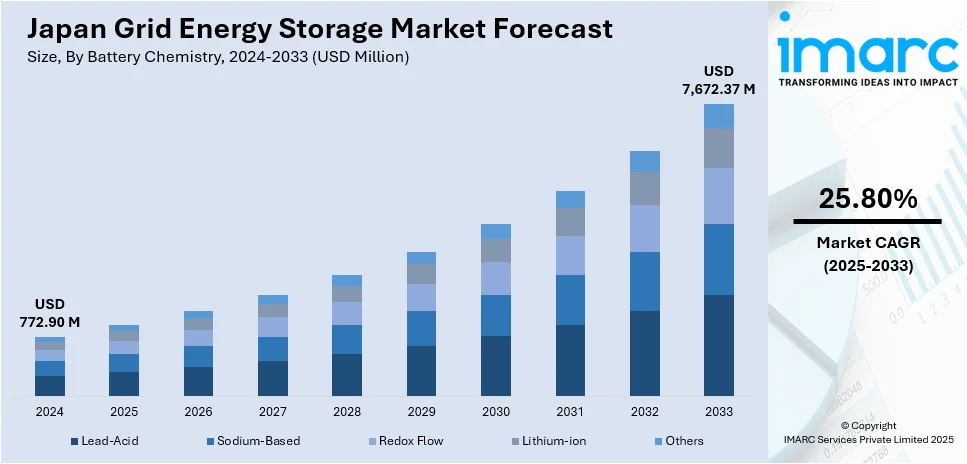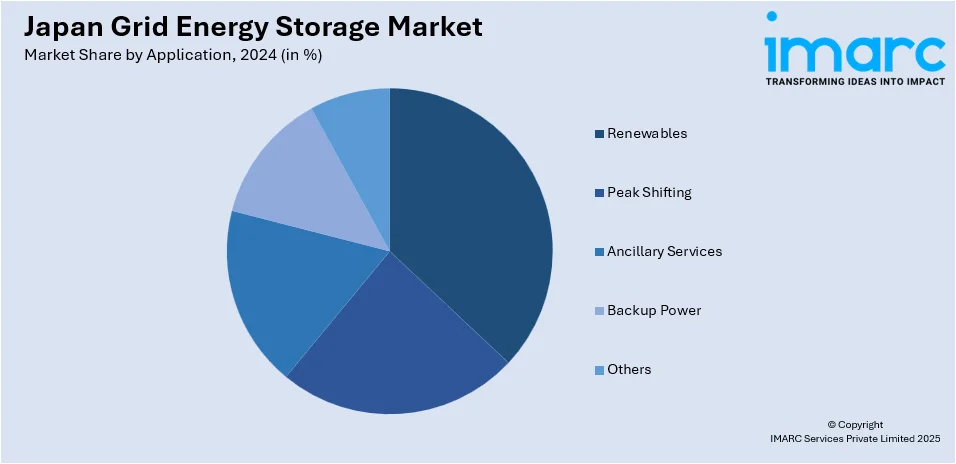
Japan Grid Energy Storage Market Size, Share, Trends and Forecast by Battery Chemistry, Ownership, Application, and Region, 2025-2033
Japan Grid Energy Storage Market Overview:
The Japan grid energy storage market size reached USD 772.90 Million in 2024. Looking forward, IMARC Group expects the market to reach USD 7,672.37 Million by 2033, exhibiting a growth rate (CAGR) of 25.80% during 2025-2033. The market is driven by the growing demand for renewable energy integration, the need for enhanced grid stability, and advancements in energy storage technologies. Increasing government support, coupled with rising electricity demand, fuels the market's growth, contributing significantly to the Japan grid energy storage market share.
|
Report Attribute
|
Key Statistics
|
|---|---|
|
Base Year
|
2024
|
|
Forecast Years
|
2025-2033
|
|
Historical Years
|
2019-2024
|
| Market Size in 2024 | USD 772.90 Million |
| Market Forecast in 2033 | USD 7,672.37 Million |
| Market Growth Rate 2025-2033 | 25.80% |
Japan Grid Energy Storage Market Trends:
Renewable Energy Integration
The growth of the Japan grid energy storage market is primarily fueled by the requirement for effective renewable energy integration. With Japan speeding up the shift towards renewable sources, mainly solar and wind power, the demand for energy storage systems that can stabilize supply and provide a steady flow of energy is increasing. Energy storage systems (ESS) promote more efficient energy production management, storing excess energy produced during peak hours of production and releasing it when demand is high or renewable output varies. As renewable energy becomes a bigger component of the country's energy mix, energy storage technologies play a critical role in matching supply and demand, supporting grid stability, and helping realize Japan's energy transition objectives. For instance, in March 2025, Kamigumi and Banpu Japan K.K. are establishing the Tokyo Uminomori Battery Business Company to build the Tokyo Uminomori Battery Energy Storage System. This grid-scale system, located in Tokyo, aims to support renewable energy adoption and stabilize grid power. The project, with a capacity of 1,999 kW and 8,226 kWh, is planned to be completed by 2028.

Government Initiatives and Policy Support
Japan's government has introduced various policies and incentives aimed at promoting energy storage systems and enhancing grid infrastructure. The government has set ambitious targets for renewable energy integration and aims to achieve carbon neutrality by 2050. As part of this commitment, significant investments are being directed towards advancing grid energy storage capabilities, including funding for large-scale storage projects and research initiatives into new storage technologies. For instance, in March 2025, Sumitomo Electric’s Redox Flow Battery has been selected for a grid-scale energy storage project by SHIN-IDEMITSU Co., Ltd., aimed at enhancing renewable energy supply in Kumamoto, Japan. The project, set for completion by October 2026, will provide 8,000 kWh of storage capacity. The battery’s durability, safety, and eco-friendly features contribute to Japan’s decarbonization goals. This regulatory and financial support is critical in driving market growth and attracting private sector investments in energy storage solutions. These efforts are expected to accelerate the adoption of grid storage systems, thereby aiding the Japan grid energy storage market growth.
Japan Grid Energy Storage Market Segmentation:
IMARC Group provides an analysis of the key trends in each segment of the market, along with forecasts at the country/regional levels for 2025-2033. Our report has categorized the market based on battery chemistry, ownership, and application.
Battery Chemistry Insights:
- Lead-Acid
- Sodium-Based
- Redox Flow
- Lithium-ion
- Others
The report has provided a detailed breakup and analysis of the market based on the battery chemistry. This includes lead-acid, sodium-based, redox flow, lithium-ion, and others.
Ownership Insights:
- Third-party Owned
- Utility Owned
A detailed breakup and analysis of the market based on the ownership have also been provied in the report. This includes third-party owned and utility owned.
Application Insights:

- Renewables
- Peak Shifting
- Ancillary Services
- Backup Power
- Others
The report has provided a detailed breakup and analysis of the market based on the application. This includes renewables, peak shifting, ancillary services, backup power, and others.
Regional Insights:
- Kanto Region
- Kansai/Kinki Region
- Central/Chubu Region
- Kyushu-Okinawa Region
- Tohoku Region
- Chugoku Region
- Hokkaido Region
- Shikoku Region
The report has also provided a comprehensive analysis of all the major regional markets, which include Kanto Region, Kansai/Kinki Region, Central/Chubu Region, Kyushu-Okinawa Region, Tohoku Region, Chugoku Region, Hokkaido Region, and Shikoku Region.
Competitive Landscape:
The market research report has also provided a comprehensive analysis of the competitive landscape. Competitive analysis such as market structure, key player positioning, top winning strategies, competitive dashboard, and company evaluation quadrant has been covered in the report. Also, detailed profiles of all major companies have been provided.
Japan Grid Energy Storage Market News:
- In May 2025, NTT Anode Energy, a subsidiary of Japan's telecom giant NTT, launched its energy storage services, including three new BESS projects in Saitama, Japan. These projects, which use lithium-ion batteries, aim to enhance grid stability and support the country's energy transition.
- In February 2025, Bison Brothers and Engelhart signed an MOU to collaborate on utility-scale battery energy storage systems in Japan. Bison Brothers will handle land acquisition, grid approvals, construction, and maintenance, while Engelhart focuses on maximizing asset value through energy trading and financial strategies. This partnership aims to enhance grid stability and accelerate Japan’s decarbonization goals.
- In September 2024, ITOCHU Corporation introduced Japan's inaugural fund for utility-scale energy storage, raising more than 8 billion yen (around USD 54 Million) from 11 public and private investors. In collaboration with Gore Street Capital, the fund aims to support new storage projects in the Kanto region, facilitating the integration of renewable energy. The first plant is scheduled to begin operations in FY2025 as part of Tokyo’s HTT initiative.
- In May 2024, Stonepeak and CHC formed a partnership to develop and operate battery energy storage projects in Japan, focusing on decarbonizing the power industry. Their platform was awarded a 20-year fixed revenue capacity market contract for four BESS projects as part of Japan’s Long-term Decarbonization Auction. The partnership aims to target 1GW of BESS projects over the next five years.
Japan Grid Energy Storage Market Report Coverage:
| Report Features | Details |
|---|---|
| Base Year of the Analysis | 2024 |
| Historical Period | 2019-2024 |
| Forecast Period | 2025-2033 |
| Units | Million USD |
| Scope of the Report |
Exploration of Historical Trends and Market Outlook, Industry Catalysts and Challenges, Segment-Wise Historical and Future Market Assessment:
|
| Battery Chemistries Covered | Lead-Acid, Sodium-Based, Redox Flow, Lithium-ion, Others |
| Ownerships Covered | Third-party Owned, Utility Owned |
| Applications Covered | Renewables, Peak Shifting, Ancillary Services, Backup Power, Others |
| Regions Covered | Kanto Region, Kansai/Kinki Region, Central/Chubu Region, Kyushu-Okinawa Region, Tohoku Region, Chugoku Region, Hokkaido Region, Shikoku Region |
| Customization Scope | 10% Free Customization |
| Post-Sale Analyst Support | 10-12 Weeks |
| Delivery Format | PDF and Excel through Email (We can also provide the editable version of the report in PPT/Word format on special request) |
Key Questions Answered in This Report:
- How has the Japan grid energy storage market performed so far and how will it perform in the coming years?
- What is the breakup of the Japan grid energy storage market on the basis of battery chemistry?
- What is the breakup of the Japan grid energy storage market on the basis of ownership?
- What is the breakup of the Japan grid energy storage market on the basis of application?
- What is the breakup of the Japan grid energy storage market on the basis of region?
- What are the various stages in the value chain of the Japan grid energy storage market?
- What are the key driving factors and challenges in the Japan grid energy storage market?
- What is the structure of the Japan grid energy storage market and who are the key players?
- What is the degree of competition in the Japan grid energy storage market?
Key Benefits for Stakeholders:
- IMARC’s industry report offers a comprehensive quantitative analysis of various market segments, historical and current market trends, market forecasts, and dynamics of the Japan grid energy storage market from 2019-2033.
- The research report provides the latest information on the market drivers, challenges, and opportunities in the Japan grid energy storage market.
- Porter's five forces analysis assist stakeholders in assessing the impact of new entrants, competitive rivalry, supplier power, buyer power, and the threat of substitution. It helps stakeholders to analyze the level of competition within the Japan grid energy storage industry and its attractiveness.
- Competitive landscape allows stakeholders to understand their competitive environment and provides an insight into the current positions of key players in the market.
Need more help?
- Speak to our experienced analysts for insights on the current market scenarios.
- Include additional segments and countries to customize the report as per your requirement.
- Gain an unparalleled competitive advantage in your domain by understanding how to utilize the report and positively impacting your operations and revenue.
- For further assistance, please connect with our analysts.
 Request Customization
Request Customization
 Speak to an Analyst
Speak to an Analyst
 Request Brochure
Request Brochure
 Inquire Before Buying
Inquire Before Buying




.webp)




.webp)












